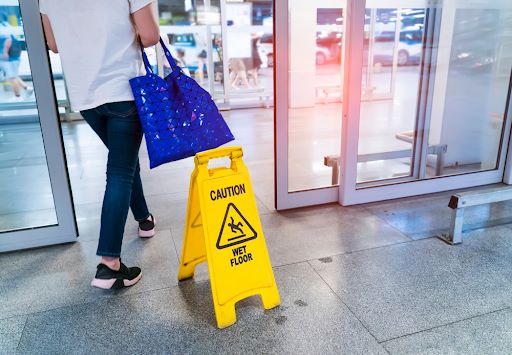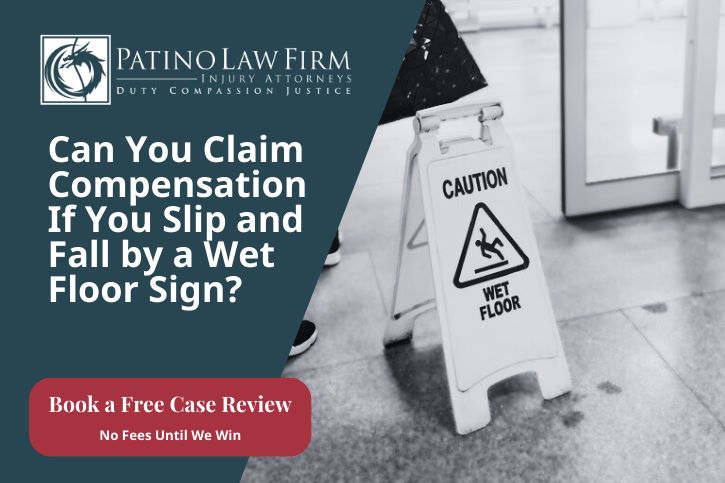Slip and fall accidents are a type of premises liability claim — so-called because they often occur on someone else’s property, such as a restaurant or grocery store. We’ve all walked down a supermarket aisle and noticed a wet spot on the floor where a pallet of goods has tipped or navigated a spillage caused by a patron dropping their glass at a bar.
When someone is injured after slipping on a wet floor, the grounds for a personal injury claim are often a failure to warn against the spillage or clean the area quickly to reduce the risk of an accident.
But what if you slipped and fell, and the establishment put down a caution sign? Can you still sue them for negligence?
In this blog, we answer that question, explaining wet floor sign laws in Texas, whether you can sue for slipping on a wet floor even if the premises warned of the risk, and how much compensation you might receive.
Understanding Texas Premises Liability Claims
Before we look specifically at the implications of wet floor signs in slip and fall claims, we must first consider the concept of premises liability in Texas, which determines if slip and fall accident victims can recover compensation for their injuries and losses.
Premises liability is the legal obligation of property owners to maintain safe premises. This concept extends to those managing or occupying a property (known as controllers). For example, a retailer in a shopping mall likely rents the premises rather than owns the entire building, but they — and, by extension, their employees — must maintain the shop and warn customers of potentially dangerous conditions.
If they do not uphold this obligation and you are injured, you can sue them for negligence.
Areas in Greater San Antonio We Serve
Texas Wet Floor Sign Laws
No law in Texas requires property owners or controllers to use wet floor signs.
However, they must keep the premises free from potential risks.
One way of maintaining safe premises is placing a wet floor sign during and after a spillage clean-up or when sanitizing floors.
But is that enough?
The presence of a caution sign shows that the owner or controller took steps to warn visitors or patrons of a potential hazard. However, it does not give businesses a free pass — you can hold them accountable if you are hurt despite there being a wet floor sign.
When Can You Sue for Slipping on a Wet Floor Sign?
Several factors come into play when determining whether you can sue after slipping near a wet floor sign. Here’s when a property might be liable for a slip and fall accident even if they warned of a hazard.
The Sign Wasn’t Visible
A property owner might be negligent if the sign cannot be seen, whether it is hidden or obstructed. For example, a staff member might place a sign around a corner or behind a shelf or pallets, meaning a person might slip without seeing it.
The sign might also be too far from the hazard, leading customers or visitors to tiptoe around or avoid an area they think is wet but isn’t, only to slip on the actual hazard 10 feet away.
The Floor Was in Poor Condition
Placing a wet floor sign may not be enough if the property owner should have reasonably taken additional precautions to ensure the floor is in a safe condition.
A sign may suffice for a small puddle or if the floor was mopped and is quickly drying. However, if the floor is excessively slippery or there is standing water, property owners must take reasonable steps to minimize the risk of a slip and fall, which might include cordoning off the area.
If spills are frequent and the area receives significant foot traffic, such as a Walmart, H-E-B, or shopping mall, another reasonable step might be to use non-slip floor tiles.
The Wet Floor Sign Was Not Placed in Time to Prevent a Slip and Fall Accident
If an employee places a sign after you have already stepped on the hazard or while you were close to it and you did not have time to avoid slipping and falling, you could claim the property owner or controller was negligent.
Other Hazards Contributed to Your Fall
A property might place a wet floor sign next to a spillage in ample time to warn visitors yet still be responsible for a slip and fall hazard. Warning about a spillage is not a defense if a property owner does not take other reasonable measures to reduce potential risks. For example, a property owner might still be liable in the following scenarios:
- A sign is placed when it is raining outside
- Staff are not periodically inspecting and cleaning the premises
- Items are improperly stored to prevent clutter or obstructions
- The lighting is poor or broken, limiting visibility.
In a personal injury claim, the law holds property owners to the following standard: Whether they have done more to prevent your accident. If the average person would have taken additional steps to reduce risk, such as placing multiple legible signs outside to warn customers about tracking rain or snow into a supermarket or diverting patrons along an alternative route so they avoid a food spillage in a restaurant, they could owe you substantial compensation for your injuries.
How Much Compensation Can You Get for a Slip and Fall Accident?
Slip and fall accidents can cause devastating injuries that impact victims for months, years, decades, or even for the rest of their lives. These injuries include:
- Fractures and broken bones: During a slip, the instinct is often to break the fall, which can cause individuals to throw out their arm and fracture their wrist or arm. But sometimes, this isn’t possible, such as when a slip and fall throws a person off-balance, and they might land on their side or back and suffer a hip injury. Even uncomplicated fractures can turn a victim’s life upside down, preventing them from working and providing for their family. More severe breaks might require surgery and recovery. In either case, a victim may suffer permanent weakness and chronic pain, affecting their quality of life.
- Head injuries: A fall can also cause a person to hit their head on the floor or a nearby object, causing concussion or more severe traumatic brain injuries. Traumatic brain injuries can require lengthy rehabilitation and cause permanent disability. The impact can also be devastating for friends and loved ones, who might need to become full-time carers or navigate a brain injury victim’s mood swings.
- Spinal cord injuries: If a slip and fall victim lands on their side, back, or neck, they might suffer a spinal cord injury, which can cause partial or complete paralysis. Often, a victim needs lifelong treatment and rehabilitation and may never recover complete movement or sensation.
- Soft tissue injuries: Soft tissue injuries such as sprains, strains, and tears can cause severe pain and limit mobility, whether temporarily or long-term.
Slip and fall accident injuries can change your life, and you can recover compensation in a premises liability claim if they result from a property owner or controller’s negligence.
Every case is unique — injuries impact individuals differently, and many factors impact settlements and court judgments — so it is difficult to put a specific figure on how much compensation you might receive in a personal injury claim without knowing about your specific situation.
However, the severity of your injuries and the extent of your losses are key factors in how much you might receive. More severe injuries often incur higher medical costs, lead to a greater loss of income, and have a larger impact on your quality of life, and these are all damages you can recover in a claim.
These damages fall into two distinct categories.
Economic Damages
Economic damages are your tangible, provable losses. Because they often result in bills, receipts, or quotes, they are easily quantified.
- Medical bills: You can recover the costs for emergency care, hospital stays, surgeries, medications, physical therapy, and any future medical expenses related to the injury.
- Lost wages: If your injury prevents you from working, you can claim compensation for the income lost during your recovery period. This can also extend to future lost earning capacity if your ability to work is permanently affected.
- Property damage: If any of your belongings were damaged during the fall, such as a broken phone or glasses, you can seek compensation for these items.
Non-Economic Damages
Non-economic damages provide compensation for the long-term impact of your injury on your life. These can be challenging to put a figure to because they’re subjective.
Non-economic damages include:
- Pain and suffering
- Loss of enjoyment
- Emotional distress
- Loss of consortium
- Loss of companionship.
How can you quantify chronic pain after a leg injury that makes walking for even a short distance uncomfortable? How much money is fair to award for the emotional distress you suffer because you have slurred speech after a head injury and cannot communicate with your loved ones? How do you put a price on the loss of emotional support and comfort previously provided by your spouse because their slip and fall accident caused a permanent cognitive disability?
The most common method of calculating non-economic damages is to apply a multiplier of up to five to the total economic damages. For example, if a slip-and-fall accident victim’s medical bills and lost wages are worth $100,000 and a multiplier of three is used, their non-economic damages will total $300,000. More severe injuries with a long-term or permanent impact warrant a higher multiplier, but the formula and criteria used to determine which number is used varies between insurers.
To see how much compensation your slip and fall accident might be worth, you can use our Texas personal injury settlement calculator. However, for the most accurate estimate of your claim’s value, we encourage you to book a free, no-obligation case review with our San Antonio and McAllen slip and fall accident attorney. We can look at the exact circumstances of your accident to determine whether the property owner was negligent — especially if there was a wet floor sign nearby — and explore your options for recovering compensation.
What You Should Do If You Slip Near a Wet Floor Sign
If you slip and fall near a wet floor sign, there are several steps you should take to protect your legal rights:
- Seek medical attention: Go to the hospital or an urgent care clinic immediately, even if you believe your injuries are minor. It’s vital to begin treatment as soon as possible. Seeing a doctor also allows you to document your injuries, and your medical records are vital evidence in your case.
- Document the scene: If possible, take photographs of the area where you fell, including the wet floor sign, the condition of the floor, and the surrounding environment. Documenting the scene can help prove whether the sign was placed next to the spillage and if the hazard was as significant as you claim.
- Report the incident: Notify the property owner or manager about the accident. Ensure the store documents the incident in an accident report and request a copy for your records.
- Gather witness information: If there were any witnesses to the accident, collect their contact information. Witness statements can provide valuable evidence to support your claim, such as whether the sign was placed in ample time for you to see it and notice the hazard.
- Consult a slip and fall accident attorney: A personal injury attorney in Texas with experience pursuing slip and fall claims can evaluate your case and advise you on the next steps. We have significant experience helping individuals who have slipped and fell in H-E-B and Walmart accidents.
You should never assume you don’t have a personal injury claim when you suffer a slip and fall, and there is a wet floor sign nearby. The property owner may be negligent, and you deserve compensation for your injuries and the long-term impact on your life.
We can assess your situation, gather evidence, and build a strong case to hold the responsible party accountable and secure the compensation you deserve to help you move forward.
Call 855-LAW-NINJA or submit a confidential contact form today to book a free, no-obligation case review with one of McAllen and San Antonio’s best personal injury attorneys. Our dedicated team has decades of combined experience pursuing premises liability claims, and we have secured six and seven-figure settlements and court judgments for our clients.
We will fight to maximize your compensation payout and never encourage you to settle for less than you deserve. You don’t pay fees until we win.



